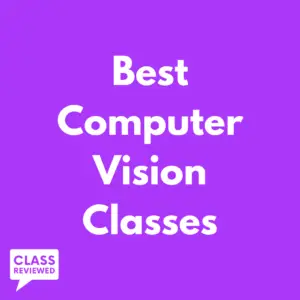So you want to upskill yourself and learn computer vision principles? Computer vision is machine learning dedicated to interpreting images and videos. The open-source computer vision library is called OpenCV (Open Source Computer Vision Library). OpenCV provides data for computer vision applications and machine learning software. Make sure to check out this guide on Learning OpenCV 4 Computer Vision with Python 3. Now it is time to dive into the 4 best Computer Vision classes we found online (which are also all free)!
Machine learning and computer vision are two of the fastest-growing sectors in artificial intelligence. The field is evolving rapidly, and if you want to get into it, there’s no better time than now. In this article, we’ll review free computer vision courses that will teach you how to build image classification systems, detect objects with OpenCV and TensorFlow, and much more!
1. Introduction to Computer Vision and Image Processing
Introduction to Computer Vision and Image Processing ⭑⭑⭑⭑⭑ 4.5/5.0 – 863 ratings – 37,899 students
Computer vision is a field of computer science and engineering concerned with the theory, development, and application of techniques that allow computers to analyze image data. While the term “computer vision” can be used to refer to the broad topic of machine perception using computational methods, it often is used in reference to the narrow subfield of human visual perception or recognition; in this sense, it generally refers to how humans draw conclusions through sight. It includes many core concepts such as image processing, object recognition, and database management.
2. Computer Vision Basics
Computer Vision Basics ⭑⭑⭑⭑☆ 4.2/5.0 – 1,776 ratings – 73,640 students
Computer vision is the ability of a computer or machine to analyze, understand and interpret images. It can be used for tasks such as object detection and recognition, facial analysis, image segmentation, image formation from video feeds, etc. You will learn the basics of computer vision in this free course.
3. Deep Learning Applications for Computer Vision Course
Deep Learning Applications for Computer Vision ⭑⭑⭑⭑⭑ 4.6/5.0 – 35 ratings – 2,953 students
Deep learning is a branch of machine learning that uses algorithms to model layers of data. The first layer may perform edge detection or it could just be an aggregation layer that gathers features from lower layers. Deep learning algorithms have achieved state-of-the-art results across many fields including computer vision, speech recognition, and natural language processing (NLP).
This class will cover the basics of neural networks and deep learning as applied to computer vision; such as detecting objects and classifying images. You’ll gain hands-on experience by implementing some basic models from scratch using TensorFlow.
Also, check out this abridged guide to Deep Learning for Computer Vision.
4. Advanced Computer Vision Class with TensorFlow
Advanced Computer Vision with TensorFlow ⭑⭑⭑⭑⭑ 4.8/5.0 – 382 ratings – 21,637 students
If you are interested in learning about the more advanced concepts of computer vision, this course is for you. It incorporates ideas from deep learning and teaches you how to build convolutional neural networks with TensorFlow.
This course will teach students how to use TensorFlow’s deep learning models for image classification, object detection, and segmentation. You’ll also learn how to apply these techniques on real-world problems like face detection or background removal (also known as segmentation).
Types of Computer Vision
There are 3 broad types of computer vision:
1) Image Processing – Images in this category are processed based on their pixels rather than their spatial structure (e.g., edge detection). This type of image processing plays a major role in pattern recognition algorithms like optical character recognition (OCR) systems where one has to identify edges within an image in order to isolate characters and words within it.
2) Shape & Appearance Modeling – Shape modeling attempts at identifying geometric properties of objects like corners or edges while appearance modeling deals more with textures and colors found on surfaces that make up an object’s surface characteristics. To give you an example, shape modeling could be used by autonomous cars so that they know what shapes they’re encountering around them thereby allowing them to navigate safely through traffic jams while appearing models would help recognize logos on other vehicles so as not to collide into them!
3) Object Recognition – Object recognition lets machines identify objects based on their visual traits such as color patterns or texture maps (these could even include moving objects too!). This type also includes face tracking (when someone enters/exits your field of view).

BONUS: Free Computer Vision Class
Deep Learning for Computer Vision by the University of Michigan
Computer vision is a growing field that has a lot of applications in today’s world. It can be used to solve problems like object detection and recognition, image enhancement, face tracking, and much more. In this article, we have listed the top four free computer vision classes which will help you learn concepts related to image processing and computer vision effectively. These classes also cover topics such as deep learning, convolutional neural networks (CNNs), and object detection using OpenCV and TensorFlow.
The demand for Computer Vision careers will only increase with computers needing to understand images, maps, self-driving cars, flight/drone usage, machine learning medical advancements, and more! Enjoy this free set of Computer Vision classes below from the University of Michigan.
